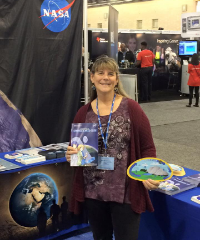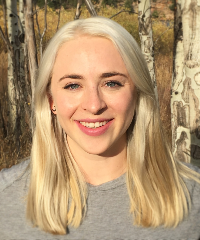Community Blogs
Community Blogs
Discover how the GLOBE community is engaging in all things GLOBE through the community blog posts below.
Learn how to create a GLOBE community blog post.
Filter By:
Blogs List
It turns out that we are most likely entering another mild La Niña winter across the globe. This article, “ La Nina Makes a Quiet Return ”, describes how scientists are able to use data on sea surface temperatures from were made by altimeters on the Jason-2 and Jason-3 satellites, and show averaged sea surface height anomalies. Climatologists are predicting that this La Niña should last through the 2017-2018 winter period in the northern hemisphere, and then should change back to neutral conditions by late spring.
Be sure to become a ...
Read More »
Posted in:
Curriculum:
STEM
TECHNOLOGY
SCIENCE AND MATH
Event Topics:
CAMPAIGNS AND PROJECTS (IOPS, ETC)
Field Campaigns:
EL NIÑO
GLOBE Science Topics:
EARTH SYSTEM SCIENCE
CLIMATE CHANGE
BACKYARD SCIENCE
CLIMATE
EARTH AS A SYSTEM
SCIENTIST SKILLS
Investigation Areas:
ATMOSPHERE
EARTH AS A SYSTEM
HYDROSPHERE
PEDOSPHERE (SOIL)
BIOSPHERE
Learning Activities:
EARTH AS A SYSTEM
ATMOSPHERE AND CLIMATE
News Topics:
SCRC RESEARCH
Primary Audience:
PARTNERS
SCIENTISTS
ALUMNI
COUNTRY COORDINATORS
TRAINERS
TEACHERS
STUDENTS
Too much water can have devastating consequences when it falls too quickly on Earth's surface. On January 9th, the " Water in Our Environment " webinar will spotlight the experiences of our GLOBE community in Asia and the Pacific.
Earlier this week in the Philippines, tropical cyclone Kai-Tak wrecked havoc on this region as it caused extreme flooding and landslides .
On December 4th and 5th, tropical cyclone Ockhi was the strongest cyclone to develop in the Arabian Sea since 2015, and it brought intense rainfall to the western part of India.
A recent CNN report stated ...
Posted in:
Curriculum:
STEM
SCIENCE AND MATH
Event Topics:
CAMPAIGNS AND PROJECTS (IOPS, ETC)
Field Campaigns:
WATERSHEDS
EL NIÑO
SMAP
GPM
GLOBE Science Topics:
EARTH SYSTEM SCIENCE
GENERAL SCIENCE
CLIMATE CHANGE
DATA INCLUDED
BACKYARD SCIENCE
CLIMATE
EARTH AS A SYSTEM
SCIENTIST SKILLS
GLOBE PROTOCOLS
Investigation Areas:
ATMOSPHERE
EARTH AS A SYSTEM
HYDROSPHERE
PEDOSPHERE (SOIL)
BIOSPHERE
Learning Activities:
EARTH AS A SYSTEM
ATMOSPHERE AND CLIMATE
LAND COVER/BIOLOGY
HYDROLOGY
SOIL
News Topics:
CALENDAR
TRAINING
Primary Audience:
PARTNERS
SCIENTISTS
ALUMNI
COUNTRY COORDINATORS
TRAINERS
TEACHERS
STUDENTS
Teacher's Guide:
INVESTIGATION AREA DOCUMENTS
Yesterday I had the pleasure of attending a hearing entitled " Gravity Never Sleeps: Landslide Risk Across the Country "at the Rayburn House Office Building that was intended to inform our lawmakers and government officials about the impacts of landslides in many parts of the United States. As the topic is related to our guiding investigative question for the ENSO Student Research Campaign - " What impacts does water, above and below ground, have on our environment? ", I thought I would share some of the things that I learned.
Jonathan Godt, the Landslide Hazard Programs Coordinator ...
Posted in:
Curriculum:
STEM
SCIENCE AND MATH
TECHNOLOGY
Event Topics:
CAMPAIGNS AND PROJECTS (IOPS, ETC)
SCIENCE SYMPOSIA AND FAIRS
Field Campaigns:
EL NIÑO
GLOBE Science Topics:
EARTH SYSTEM SCIENCE
CLIMATE CHANGE
DATA INCLUDED
BACKYARD SCIENCE
CLIMATE
EARTH AS A SYSTEM
SCIENTIST SKILLS
GLOBE PROTOCOLS
GLOBE Working Groups:
EDUCATION WORKING GROUP
Investigation Areas:
ATMOSPHERE
EARTH AS A SYSTEM
HYDROSPHERE
PEDOSPHERE (SOIL)
BIOSPHERE
Learning Activities:
EARTH AS A SYSTEM
ATMOSPHERE AND CLIMATE
LAND COVER/BIOLOGY
HYDROLOGY
SOIL
News Topics:
VIRTUAL SCIENCE FAIR
REGIONS
TRAINING
Primary Audience:
PARTNERS
SCIENTISTS
ALUMNI
COUNTRY COORDINATORS
TRAINERS
TEACHERS
STUDENTS
Learning science involves learning important concepts, conducting experiments to see first-hand how researchers discovered and confirmed some elements of science concepts, and learning how to think scientifically. With this complete approach to learning science, students are well-prepared to deal with the natural world around them and to make wise decisions when confronted with various choices. The ability to think scientifically is a valuable skill in almost all aspects of life and doing science teaches scientific habits of mind.
Students can do science through research projects ...
Posted in:
Curriculum:
STEM
SCIENCE AND MATH
GLOBE Science Topics:
SCIENTIST SKILLS
GENERAL SCIENCE
BACKYARD SCIENCE
GLOBE Working Groups:
SCIENCE WORKING GROUP
Investigation Areas:
ATMOSPHERE
EARTH AS A SYSTEM
HYDROSPHERE
PEDOSPHERE (SOIL)
BIOSPHERE
News Topics:
VIRTUAL SCIENCE FAIR
COMPETITIONS
Primary Audience:
TEACHERS
STUDENTS
PARTNERS
COUNTRY COORDINATORS
What are the impacts of extreme events, like Hurricane Harvey, on the water quality? This article from the Smithsonian magazine describes multiple ways in which public health officials are responding to several threats facing residents of Houston and surrounding locations. These threats include the impact of mold, the potential of an increase in vector-borne diseases such as Zika and West Nile virus, and the problems of contaminants left behind in the public water supply.
Have you experienced severe flooding in your region that resulted in problems with water quality? ...
Posted in:
Curriculum:
STEM
SCIENCE AND MATH
Event Topics:
CAMPAIGNS AND PROJECTS (IOPS, ETC)
SCIENCE SYMPOSIA AND FAIRS
Field Campaigns:
EL NIÑO
WATERSHEDS
GLOBE Science Topics:
EARTH AS A SYSTEM
CLIMATE CHANGE
BACKYARD SCIENCE
CLIMATE
Investigation Areas:
ATMOSPHERE
EARTH AS A SYSTEM
HYDROSPHERE
PEDOSPHERE (SOIL)
BIOSPHERE
News Topics:
SCRC RESEARCH
The journal Scientific American just published a blog about GLOBE. The post, titled " The GLOBE Program: Making the Case for K–12 Citizen Scientists " discusses several aspects of GLOBE, including our contributions and campaigns. As well, it helps explain our mission of providing the resources for students across the world to become citizen scientists.
"Contributing to global datasets not only gives students a chance to collect data that scientists can actually use, but allows them to compare their experiences and findings with other students around the world."
To read more ...
Posted in:
Event Topics:
CAMPAIGNS AND PROJECTS (IOPS, ETC)
OTHER
Field Campaigns:
EL NIÑO
SURFACE TEMPERATURE
GLOBE Science Topics:
SCIENTIST SKILLS
GLOBE PROTOCOLS
BACKYARD SCIENCE
Primary Audience:
TRAINERS
TEACHERS
STUDENTS
PARTNERS
SCIENTISTS
ALUMNI
COUNTRY COORDINATORS
In my previous blog post, I showed the results of my surface temperature experiment. It was a great way to highlight some of the practical ways to use science, and it was yet another way for me to talk about my puppy. My experiment and accompanying blog was straightforward enough. I identified a problem, I designed an experiment, collected data, and presented the results. This is how science is done, right?! With years of experiment experience behind me, this should have been a very fast and easy task, but I had one problem that I forgot to account for, my Attention Deficit Disorder. ...
Posted in:
GLOBE Science Topics:
BACKYARD SCIENCE
SCIENTIST SKILLS
EARTH AS A SYSTEM
EARTH SYSTEM SCIENCE
Investigation Areas:
SURFACE TEMPERATURE
These are the results from my surface temperature experiment that I discussed in my previous blog post (same title, part 1).
Results and Conclusion :
Figure 2: Graph of average surface temperatures of the three surfaces over three days including air temperature data lines.
My results show that my hypothesis was half right (remember, it’s ok if your data results do not match your hypothesis!). During the day, asphalt was the hottest, concrete was in the middle, and grass was the coolest. The surface temperatures of all three dropped at night, however, I was ...
Posted in:
GLOBE Science Topics:
BACKYARD SCIENCE
DATA INCLUDED
GLOBE PROTOCOLS
EARTH SYSTEM SCIENCE
SCIENTIST SKILLS
Investigation Areas:
SURFACE TEMPERATURE
News Topics:
VIRTUAL SCIENCE FAIR
In case you missed it, last month, was all about the 2017 International Virtual Science Symposium . There were over 140 entries from all 6 GLOBE regions. Students submitted reports about their research on all of the “spheres” (hydrosphere, atmosphere, biosphere, pedosphere, and earth as a system) and they were reviewed by a panel of scientists, teachers, and science enthusiasts to be rewarded with stars and badges.
I had the wonderful privilege of being able to read through and review several projects. I was blown away with the thought and hard work that went into these ...
Posted in:
GLOBE Science Topics:
BACKYARD SCIENCE
DATA INCLUDED
EARTH SYSTEM SCIENCE
SCIENTIST SKILLS
GLOBE PROTOCOLS
Investigation Areas:
SURFACE TEMPERATURE
News Topics:
VIRTUAL SCIENCE FAIR
Just when you think that perhaps the weather systems are settling down- our amazing scientific instruments are able to detect a potential change! I never cease to be amazed at what we are able to learn about Earth's systems- both from the ground and from space!
This article from the New York Times just came across my newsfeed- " It's Like it Never Left: Another El Nino May be on the Way ".
In the article, it states that " Among the potential effects are wetter conditions across the southern United States, including Southern California; a drier Midwest; and drought in ...
Posted in:
Curriculum:
STEM
EDUCATION RESEARCH
SCIENCE AND MATH
Event Topics:
CAMPAIGNS AND PROJECTS (IOPS, ETC)
Field Campaigns:
EL NIÑO
GLOBE Science Topics:
EARTH SYSTEM SCIENCE
CLIMATE CHANGE
BACKYARD SCIENCE
CLIMATE
EARTH AS A SYSTEM
SCIENTIST SKILLS
GLOBE PROTOCOLS
GLOBE Working Groups:
EDUCATION WORKING GROUP
Investigation Areas:
ATMOSPHERE
EARTH AS A SYSTEM
HYDROSPHERE
PEDOSPHERE (SOIL)
BIOSPHERE
News Topics:
VIRTUAL SCIENCE FAIR
Primary Audience:
PARTNERS
SCIENTISTS
ALUMNI
COUNTRY COORDINATORS
TRAINERS
TEACHERS
STUDENTS
Consider the rain gauge used in GLOBE, CoCoRaHS, and other citizen science programs. Just four pieces plus 2 mounting screws – an inner graduated cylinder, an outer cylinder, a cap/funnel, and a mounting bracket. The area of the outer tube is exactly 10 times the areas of the inner tube and the cap/funnel, so the graduations on the inner cylinder can be spaced ten times further apart. Thus, 0.2 mm of rain fills the inner tube to a depth of 2.0 mm, which one can read.
In addition, if heavy rainfall fills the inner cylinder, the rest of the rainfall overflows into the outer cylinder, ...
Posted in:
Curriculum:
STEM
Field Campaigns:
EL NIÑO
GPM
GLOBE Science Topics:
BACKYARD SCIENCE
GLOBE PROTOCOLS
Investigation Areas:
ATMOSPHERE
Primary Audience:
TEACHERS
STUDENTS
ALUMNI








